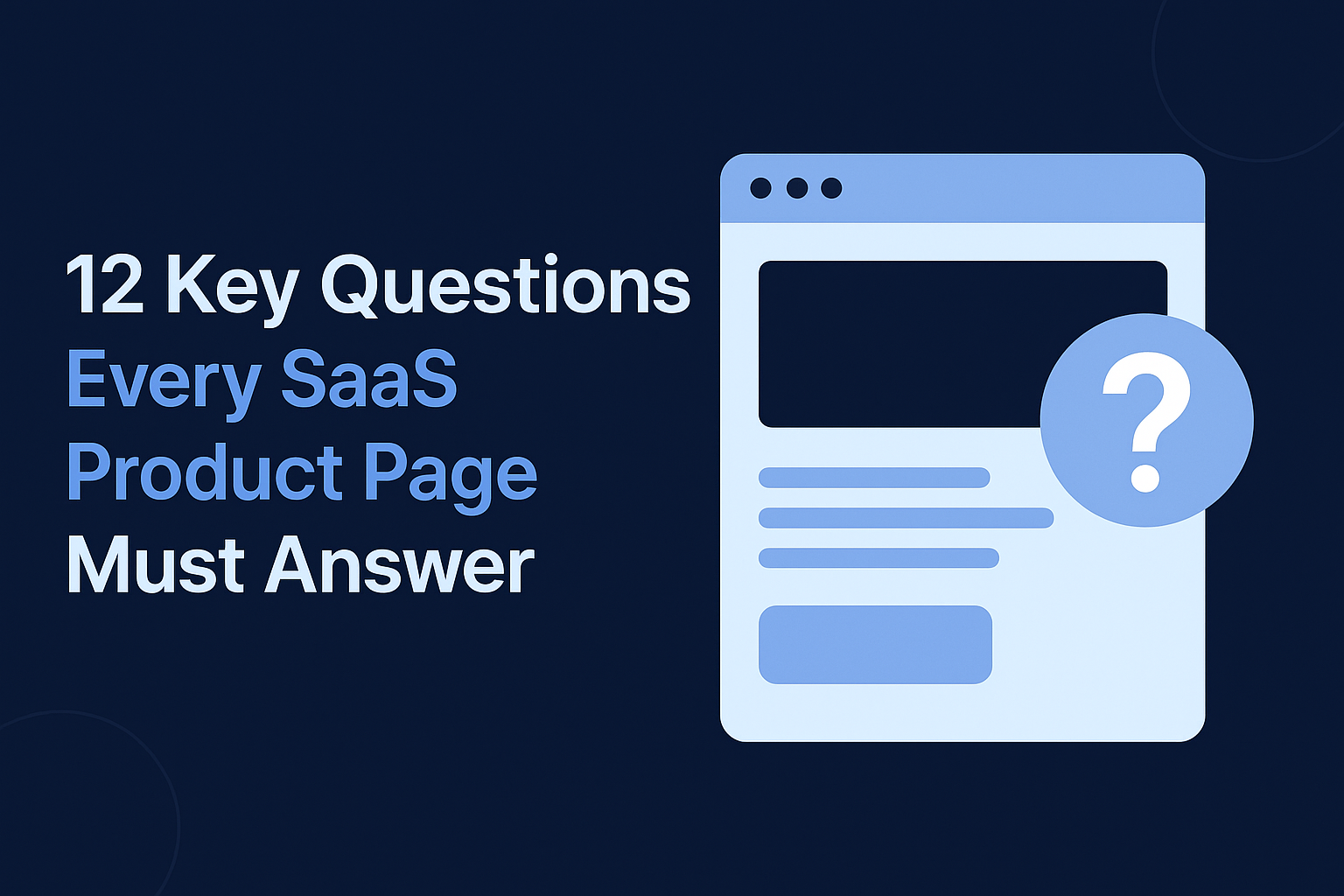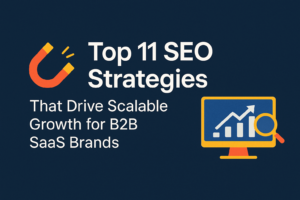In B2B SaaS, a product page is more than a static brochure. It’s where revenue decisions happen. While awareness-stage blogs and thought-leadership posts pull prospects into your orbit, the product page is where you win or lose deals.
The landscape is shifting. Google’s AI Overview and zero-click search trends mean that prospects often see summarized answers directly in search results. If your page is incomplete, vague, or structured poorly, those answers will come from someone else likely your competitor.
The solution? Build your product page as the ultimate, question-answering hub. Your goal is to satisfy the exact informational needs of your audience, so comprehensively and clearly, that Google and AI models can’t help but treat your content as the go-to source.
Here are the 12 questions that every SaaS product page must answer in depth to capture clicks, build trust, and close deals faster.
1. What problem does this product solve?
This is your hook. Prospects don’t land on your page to admire features; they arrive because they have a pain point. You need to articulate that pain so precisely that they nod along while reading.
Instead of vague claims like “We help businesses grow,” address the core problem:
- Is the issue inefficiency?
- Data silos?
- High manual workload?
- Inability to track performance?
Example narrative:
“Most mid-size marketing teams spend 25% of their week on manual reporting and cross-platform data gathering. Campaign results arrive too late, decisions stall, and opportunities are lost. Our platform eliminates this by automatically integrating every data source, updating metrics in real time, and making performance insights available instantly.”
SEO keyword mapping:
- Primary: “problems SaaS solves”
- Secondary: “SaaS solutions for [pain point]”, “how to fix [pain point]”
Why this counts: Google’s AI Overview loves clearly stated problem-solution formats. If you frame the problem using customer language, you increase the likelihood your copy is quoted directly.
2. Who is this product for?
A well-qualified lead is worth more than 100 casual visitors. If you clearly define your target audience, you help the right people identify themselves — and the wrong ones bounce, saving you unqualified pipeline noise.
Describe your ICP (Ideal Customer Profile) without narrowing yourself into an SEO dead end:
- Company size range (e.g., small teams to enterprise divisions)
- Industry fit (broad categories unless niche is strategic)
- Roles and departments that benefit most
Example narrative:
“Our solution is built for fast-growing B2B teams who need campaign data at their fingertips. Whether you’re a marketing director overseeing multiple brands, a RevOps lead aligning pipeline reporting, or a founder managing lean teams, our tools adapt to your workflow and scale as you grow.”
SEO keyword mapping:
- Primary: “who should use [product category]”
- Secondary: “SaaS tools for marketing managers”, “software for RevOps”
3. What are the key features and how do they work?
Features are the proof that your solution can solve the problem. But instead of dumping a bullet list, expand each feature into a micro-case that explains what it does and why it matters.
Example narrative:
Automated Campaign Reports
“On average, marketers spend 8 hours a week compiling cross-platform performance data. Our automated reporting eliminates this by pulling metrics from all connected channels, applying your chosen KPIs, and delivering ready-to-share reports to your inbox every Monday, without fail.”
Custom Dashboard Views
“Different roles need different insights. Customize dashboards by user so marketing sees creative performance, sales sees pipeline attribution, and leadership sees revenue impact.”
SEO keyword mapping:
- Primary: “key features of [product category]”
- Secondary: “how [feature] works”, “best features of SaaS tools”
4. What makes this product different or better?
Your competitors are just one tab away. To win the comparison game, you need specific differentiators backed by measurable proof:
- Speed (“Go live in 5 days vs 14-day industry average”)
- Reliability (“99.9% uptime validated by third-party audits”)
- Pricing structure (“No surprise overage fees — ever”)
Example narrative:
“Unlike tools that require weeks of onboarding, our plug-and-play integrations mean your team is fully operational in under a week with zero developer intervention. That’s 3x faster than the industry average, which means you start seeing ROI sooner.”
SEO keyword mapping:
- Primary: “why choose [product] over competitors”
- Secondary: “[product category] with fastest setup”, “best SaaS for [specific need]”
5. How does the product work in action?
B2B buyers want clarity. Outline your product workflow in simple, logical steps:
- Sign Up — Create your account in minutes.
- Integrate Tools — Connect CRM, ad platforms, and analytics with one click.
- See Results — Dashboard insights start populating instantly.
Pro tip: A short explainer video can increase conversion rates by 80%+ (Wyzowl, 2024).
SEO keyword mapping:
- Primary: “how [product] works”
- Secondary: “SaaS workflow example”
6. What are common use cases?
Use cases help prospects imagine themselves succeeding with your product.
Each should follow the Problem → Solution → Outcome model.
Example narrative:
Use Case: Accelerating Quarterly Reporting
“A mid-size marketing agency reduced reporting time from 10 days to 2 by automating data aggregation and visualization. The result? Leadership reviews shifted from lagging to real-time insights, improving decision speed by 35%.”
- Primary: “use cases for [product category]”
- Secondary: “examples of [product] in action”
7. How Long Does Implementation Take?
One of the biggest anxieties for B2B SaaS buyers is downtime. Any disruption in workflows can mean missed deadlines, frustrated teams, and a loss of revenue. That’s why clarity here is non-negotiable.
Instead of vague promises like “quick setup,” address the real question buyers are asking: How soon will my team be up and running without headaches?
Expanded narrative:
Most mid-sized teams are fully operational within 5–7 business days. This includes:
- Seamless integration with your existing tech stack
- Dashboard personalization so the platform matches your workflows
- Step-by-step staff onboarding with guided tutorials
For enterprise-level rollouts with custom security layers or complex data migration, the timeline averages 2–3 weeks. To minimize disruption, we run a parallel onboarding track so your current processes continue uninterrupted until the switch is complete.
This sets realistic expectations, removes fear of the unknown, and positions your product as low-friction from day one.
8. How Much Does It Cost?
Pricing is one of the top reasons prospects bounce from product pages. Not having enough detail here can lead them straight into a competitor’s arms.
Your audience not just looking for a number they want a pricing framework that makes sense for their budget, growth plans, and ROI expectations.
Expanded narrative:
Our pricing is tier-based, aligning with the number of active users and the depth of features required. Each tier includes:
- Full access to all core features (no feature gating)
- Unlimited integrations to connect with your existing tools
- 24/7 customer support across all channels
There are no hidden fees, no surprise bills during scaling, and no “pay extra for basic features” traps. For growing teams, scaling is straightforward — simply move to the next tier without downtime or reconfiguration.
By addressing both cost transparency and predictability, you eliminate one of the biggest purchase blockers in SaaS sales.
9. What Kind of Support Will I Get?
For B2B decision-makers, especially in high-stakes SaaS adoption, support is often the deal-maker. They’re not just buying software they’re buying partnership and reliability.
Expanded narrative:
We provide multi-channel support 24/7 — live chat, email, and phone. Customers on professional and enterprise plans are paired with a dedicated account manager who knows their setup inside out.
To empower teams further, our self-service knowledge base offers over 500 searchable articles, troubleshooting guides, and process checklists. Weekly onboarding webinars and quarterly success reviews ensure your team keeps evolving alongside the product.
This approach makes support proactive, not reactive, giving buyers confidence they won’t be left scrambling if something goes wrong.
10. Is This Product Secure and Compliant?
For procurement teams, security is often the first filter in their evaluation process. If your product doesn’t meet their compliance and protection standards, it may be eliminated before you even get the chance to present it.
Expanded narrative:
We adhere to the highest security protocols, including:
- AES-256 encryption for all data in transit and at rest
- SOC 2 Type II certification for operational security
- Full compliance with GDPR and other major data protection laws
- Hosting in ISO 27001-certified facilities with 24/7 monitoring
We also conduct regular third-party security audits and penetration testing to ensure ongoing resilience. For industries with stricter requirements, we provide custom compliance documentation to accelerate procurement approval.
11. What Do Existing Customers Say?
Social proof remains one of the most persuasive levers in B2B SaaS sales. Your audience wants to hear from someone like them who’s already achieved measurable wins.
Expanded narrative:
“After implementing the platform, our team reduced reporting time from three days to 45 minutes, freeing up analysts to focus on strategy instead of spreadsheets.” — Director of Marketing, Mid-Market SaaS
We showcase case studies, verified testimonials, and star ratings via structured data markup so they appear directly in search results. This not only boosts credibility but also increases click-through rates from SERPs.
12. What Should I Do Next?
A clear, low-risk call-to-action closes the loop and removes final hesitation. If your CTA is too vague, users will leave even if they were ready to act.
Expanded narrative:
Your next step is simple:
Start a free, no-credit-card-required trial today.
Within 24 hours, you’ll have your first set of actionable insights and hands-on experience with the platform.
For larger teams, we offer a guided pilot program where your account manager walks you through setup, integration, and success metrics ensuring you see real-world value before committing.
Bringing It All Together: Building an AI-Optimized SaaS Product Page
By now, you’ve seen how each of these 12 questions addresses a critical buyer hesitation. But here’s where it all connects: in the age of Google’s AI Overview and zero-click search, your product page is not only competing with other vendors it’s also competing with AI summaries themselves.
That means your content needs to do two jobs at once:
- Satisfy AI parsing and ranking requirements
- Use direct, plain-language answers to each question so AI models can extract and display them in search results.
- Structure with clear H2/H3 headings, bullet points, and short, authoritative paragraphs for scannability.
- Include primary and secondary keywords naturally within answers, not forced into intros.
- Convert human readers on-page
- Back up every answer with measurable outcomes or proof points.
- Use visual assets (screenshots, micro-demo clips, comparison charts) to reinforce trust.
- Ensure every scroll depth has a relevant CTA, so the reader never has to scroll back up to take action.
When you apply this dual optimization approach, you create a content asset that both Google trusts and buyers believe.
Transforming Your Product Page into a Sales Powerhouse
A product page should never feel like a static brochure gathering digital dust. Done right, it becomes a high-performing sales tool that works around the clock, guiding visitors toward the decision to buy. When you address all 12 key questions with clarity, substance, proof, and building trust. Trust that convinces a prospect they’ve found the right solution. Trust that removes hesitation and makes the next step obvious.
Every gap in information is an open door for a competitor to walk through. Every vague benefit or weak proof point leaves room for doubt. And every missing or unclear call-to-action is a lost chance to convert. Instead, aim for a page that anticipates every concern, answers every question, and gives the visitor all the evidence they need to act. The result? A product page that doesn’t just attract traffic, but consistently turns interest into revenue.

vetrivel is an accomplished SEO and digital marketing expert with 5 plus years of experience. dedicated to providing readers with informative and engaging content.




